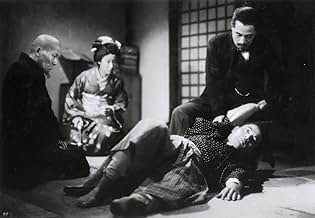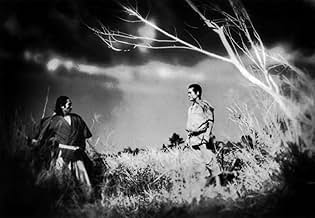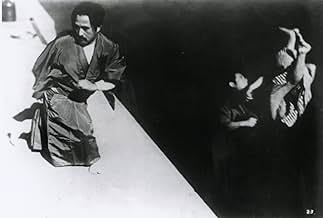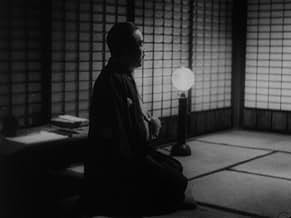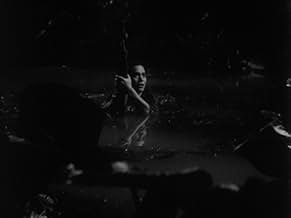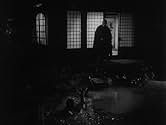Sugata, a young man, struggles to learn the nuance and meaning of judo, and in doing so comes to learn something of the meaning of life.Sugata, a young man, struggles to learn the nuance and meaning of judo, and in doing so comes to learn something of the meaning of life.Sugata, a young man, struggles to learn the nuance and meaning of judo, and in doing so comes to learn something of the meaning of life.
- Director
- Writers
- Stars
- Hatta
- (as Michisaburo Segawa)
- Monma's pupil
- (uncredited)
- Director
- Writers
- All cast & crew
- Production, box office & more at IMDbPro
Featured reviews
Sugata Sanshiro proudly carries his name. Man of the people, attending a school of Jiu Jitsu, a martial art which derive Judo, a risky way to debug the techniques, paradoxically, called "art of softness". But when he meets the skill of the master judoka Yano, Sanshiro decides to become his student and then faced the challenges that will give him a place in the new institute.
What follows then are the circumstances of life that prove the man to his ideals and give opportunity to specify the strength of their inclinations. For it is with chiselases which are polished gems and it is with fire that demonstrates the strength of the metal. But there are things that weigh in man, as love is born and who never wants to hurt, and then, when man is forced to the difficult choice between self- interest or what benefits the group.
I think, "Sugata Sanshiro", was a good start for the master Kurosawa. The film denotes human sense, defending the rules and the collective interest, as it should be, but also understands the meaning of love and compassion, and rejoices as they deserve. The director shows fairly distanced with the scenes of violence, and although I'm sure weighed and weighed now more than ever, this gives a clear account of its central goal was the feeling and no physical force. After all, is in being and not in the domination, as a man can know himself, and as the teacher Yano says:"The way is the search for truth that governs the nature of man, as this is what will give us a peaceful death."
It must have been that this first film was well received at the box office since, two years later, the third Akira Kurosawa film, continue the story with the title "Soku Sugata Sanshiro". There is only regrettable that so valuable a work, with moments of undeniable beauty plastic, and is committed to a positive outlook on life, Japan's clumsy censorship of the time (¿perhaps there will not be clumsy censorship?), has cut about 600 feet, which may never recover and leave the film in some way unfinished.
Against all, I think any fan of the great Japanese filmmaker, should be deprived of seeing this remarkable debut.
There are little notes to take for Kurosawa fans, little things that will give many a grin and even a laugh at what pops up: the classic "wipes" as means of scene transitions; the usage of slow-motion during an action/fight sequence, in this case at the end of a fight as the opponent conks out and the flag (this part in slow-motion) falls to the ground; Takashi Shimura, who appeared in more Kurosawa films than Mifune, as one of Sugata's opponents, who's a tough cookie but a fair fight who at the end gives Sugata praise as a great fighter; symbolism in usage of the sky, flowers, and other Earthly means as a way to communicate the environment of a scene, and a specific nature about it, as much as the characters in it. All the same, this is not to say that Sanshiro Sugata is exactly a masterwork right off the bat for the 32 year old filmmaker; the use of certain symbols, like when Sugata is in the mucky pond trying to have his own form of penance and snaps out of it once seeing a flower right in front of his face, isn't really as effective as intended and comes off as more of a cliché than anything else. The subplot with Sugata and the daughter is undercooked as romance, even as brief as it is. And the fact that the film now stands as missing 17 minutes is a hindrance; one has to comment on what remains as opposed to what could have been a complete work from Kurosawa (not as detrimental as the Idiot, but still bothersome all the same as in the title-card transitions).
But as an act of passionate action film-making, it stands its ground some 60+ years later in containing some intense scenes involving Sugata's training (I liked seeing Sugata coming face to face with a man who wants to challenge his boss, and dressed in more Western garb than anyone else in the film), and more specifically the actual fight scenes. While its a given that Kurosawa is a pro at getting down stubborn men- and professional traditionalist men for that matter- getting down and dirty and violent, it's impressive in hindsight from the rest of his career that he could add tension just by tilting the camera up during the street-fight, or in staying on the faces of the fighters, and numerous reaction shots, during the fights in the arena area. The Shimura fight especially has an aura of being as thrilling as a modern fight sequence, with aforementioned humanity coming through with every pummel and thrust and toss-up of one character over another. This all leads up to the climax, which is not only a highlight of the film but a highlight in the history of classic Japanese action sequences, as we see Kurosawa already relying on the sky, the grass pushed and pulled by wind, and the compassion of the others around the two opponents (the old man and the girl) as a fight to the death, seen mostly out of sight through the grass, proceeds intensely more due to the intent and emotion of the characters than traditional stunts and fast-pace editing.
Sanshiro Sugata is a worthy production in the cinematic cannon of Kurosawa, acting as a very good stand-alone effort for genre fans while speaking to his practically intuitive cinematic strengths at controlling the pace of a scene and meaning via certain visual cues and enjoyable performances garnered by the pro actors. It does show some of its age, and along with the cuts made in the only version available today (in a print, by the way, that is rather horrid considering who the director is) it had to face some given restrictions due to Japan's censorship laws, but it's also a cunning display of a debut showcasing the talents of a confident director in a film that was meant to be seen by a mass audience, if only for diversion during the war.
According to a very interesting online article by Walter Klinger, the film was submitted to two distinct forms of censorship. First of all, during production, from government censors urging Kurosawa to make a film glorifying Japanese warriors and their spirit of devotion to "chuukou", i.e. "loyalty and devotion" understood as an infallible principle requiring absolute loyalty to one's superiors and blind obedience to orders (a principle that made Kamikaze pilots possible). In the pond scene, Sanshirô's master urges him to follow "chuukou" and after his nighttime revelation, Sanshirô bows obediently to his master.
In the post-war period, all references to this principle were outlawed by the General Headquarters of the Supreme Commander for the Allied Forces (SCAF - the occupying Americans) as an anti-social remnant of Japanese feudalism which was perceived as the root cause of Japan's stubborn refusal to surrender. Not only was the "chuukou" word excised from that scene in mid-sentence (and never put back in, even in the "restored" version) but all subsequent editions of the novel the film was based on, even in animé or manga form or in film remakes and sequels, were also excised for the same reason, which means that the hero was reduced to finding "satori" in other more universal Zen sources or nuanced feelings, such as the love of his beloved, the realization of his own selfishness or respect for his master.
As post-war young Japanese people weren't particularly fond of "chuukou" to begin with, especially as it concerned blind devotion to tradition and unconditional loyalty to one's parents (or employers), this was not seen as a major problem.
The SCAF, however, also outlawed scenes of feudal loyalty, cruel violence and the "undemocratic idea of revenge", "feudal" commodities for which the Japanese public never really lost its tremendous appetite, and which eventually became the main themes of Yakuza, samurai and martial arts films. Furthermore, martial arts, including judo, with their stigma of "warrior's ways" and "blind obeisance", were also banned from government-sponsored settings like schools and police departments, until 1950, at the very time when they were conquering the rest of the civilized world, including America.
Did you know
- TriviaWhen asked about his experience filming his debut movie, Akira Kurosawa said "I simply enjoyed it. I went to sleep each night looking forward eagerly to the next day's shooting, and there was absolutely nothing painful in the experience... the whole task was carried out with a feeling of ease."
- Quotes
Sanshiro Sugata: The spirits of heaven and earth congregate in our nation of gods. For us they have built Mt. Fuji that towers for eternity. For us they have brought water to flow around our islands. For us they have created the beauty of cherry blossoms...
[he stops and remembers Sayo]
Buddhist Priest: [hits Sanshiro on the head] Idiot! This is an important match. What the hell are you thinking?
Sanshiro Sugata: I can't do it. I can't win.
Buddhist Priest: What? Are you afraid of Hansuke Murai?
Sanshiro Sugata: No. Someone stands between him and me.
Buddhist Priest: Who?
Sanshiro Sugata: His daughter.
Buddhist Priest: You love her?
Sanshiro Sugata: No. It's not that. Priest, I saw her praying selflessly for her father. It was beautiful and I was touched. That's the problem. How can I overcome it?
Buddhist Priest: Stupid! Be pure and innocent like her.
Sanshiro Sugata: I can't.
Buddhist Priest: You can. You once were.
Sanshiro Sugata: When?
Buddhist Priest: [pointing to the pond] Sanshiro Sugata found new life there. Have you forgotten? What is your life, Sanshiro?
- Alternate versionsAlthough originally released in Japan at 97 minutes, it was re-edited and re-released in Japan in 1952 at 80 minutes. This 80-minute version is all that is currently available, and it includes some slight changes in the film's structure as well as its running time.
- ConnectionsFeatured in Kurosawa: The Last Emperor (1999)
- How long is Sanshiro Sugata?Powered by Alexa
Details
- Release date
- Country of origin
- Language
- Also known as
- La légende du grand judo
- Filming locations
- Toho Studios, Tokyo, Japan(Studio)
- Production companies
- See more company credits at IMDbPro
- Runtime1 hour 19 minutes
- Color
- Sound mix
- Aspect ratio
- 1.37 : 1
Contribute to this page


